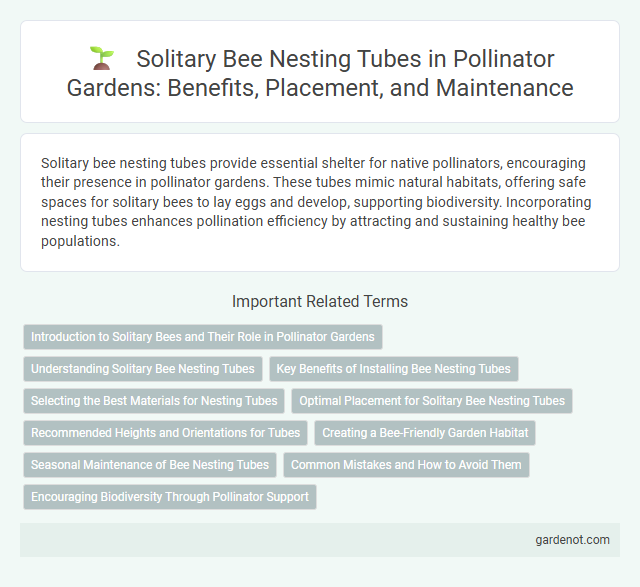Solitary bee nesting tubes provide essential shelter for native pollinators, encouraging their presence in pollinator gardens. These tubes mimic natural habitats, offering safe spaces for solitary bees to lay eggs and develop, supporting biodiversity. Incorporating nesting tubes enhances pollination efficiency by attracting and sustaining healthy bee populations.
Introduction to Solitary Bees and Their Role in Pollinator Gardens
Solitary bees are essential pollinators that do not live in colonies but nest individually in tubes or small cavities, playing a crucial role in supporting plant biodiversity in pollinator gardens. These bees efficiently pollinate a wide variety of flowers, fruits, and vegetables, enhancing garden productivity and ecosystem health. Providing solitary bee nesting tubes offers a safe habitat, encouraging their presence and promoting sustainable pollination.
Understanding Solitary Bee Nesting Tubes
Solitary bee nesting tubes provide essential habitats for solitary bee species, supporting their reproduction by mimicking natural nesting environments such as hollow stems or cavities. These tubes, made from materials like bamboo, paper, or wood, offer protection from predators and harsh weather, ensuring successful larval development. Incorporating nesting tubes into pollinator gardens promotes biodiversity and enhances pollination efficiency by attracting and sustaining solitary bee populations.
Key Benefits of Installing Bee Nesting Tubes
Installing solitary bee nesting tubes supports native pollinator populations by providing safe, pesticide-free habitats that promote breeding and increase local biodiversity. These tubes improve pollination efficiency, enhancing the growth and yield of nearby plants and crops. Offering a natural alternative to ground nesting, they help protect solitary bees from predators and environmental stressors, boosting overall ecosystem health.
Selecting the Best Materials for Nesting Tubes
Selecting the best materials for solitary bee nesting tubes involves prioritizing natural, untreated wood or paper fibers that mimic the bees' innate habitats. Bamboo tubes and reeds with smooth inner surfaces and appropriate diameters between 4 to 10 millimeters provide ideal nesting conditions, promoting successful brood development. Avoiding toxic finishes and ensuring moisture resistance enhances the longevity and safety of these nesting sites, supporting solitary bee populations effectively.
Optimal Placement for Solitary Bee Nesting Tubes
Optimal placement of solitary bee nesting tubes involves situating them in a sunny, sheltered location that remains dry and faces southeast to capture morning sunlight. Elevating the tubes at least 3 feet above ground level helps protect them from predators and moisture. Positioning near native flowering plants enhances foraging efficiency, supporting healthy solitary bee populations.
Recommended Heights and Orientations for Tubes
Solitary bee nesting tubes perform best when installed at heights ranging from 3 to 6 feet above ground, optimizing accessibility and protection from predators. Tubes should face southeast to maximize morning sunlight, promoting early bee activity and warmth. Ensuring tubes are positioned in a sheltered spot, away from heavy winds and direct rain, enhances occupancy and successful nesting.
Creating a Bee-Friendly Garden Habitat
Solitary bee nesting tubes provide essential shelter for native bee species, enhancing pollination and biodiversity in a pollinator garden. These tubes mimic natural cavities, offering safe spaces for solitary bees to lay eggs and thrive. Incorporating nesting tubes alongside diverse flowering plants creates a robust, bee-friendly habitat that supports healthy ecosystems.
Seasonal Maintenance of Bee Nesting Tubes
Seasonal maintenance of solitary bee nesting tubes involves cleaning and replacing tubes after each active season to prevent disease buildup and parasite infestation. Removing debris and sealing tubes during winter protects larvae from harsh weather conditions and predators, ensuring higher survival rates. Proper maintenance directly supports solitary bee population health, promoting effective pollination in garden ecosystems.
Common Mistakes and How to Avoid Them
Common mistakes when using solitary bee nesting tubes include improper placement, such as exposing tubes to direct rain or intense sunlight, which can harm developing bees. Using tubes of incorrect diameter or materials not suitable for solitary bees reduces nesting success and may invite predators or parasites. To avoid these issues, place nesting tubes in sheltered, sunny locations with tube diameters between 4-10 mm, and regularly clean or replace tubes to maintain a healthy pollinator garden.
Encouraging Biodiversity Through Pollinator Support
Solitary bee nesting tubes provide essential habitats for solitary bee species, promoting their reproduction and population growth within pollinator gardens. By offering a safe place for nesting, these tubes enhance local biodiversity and improve pollination rates for native plants and crops. Supporting solitary bees through targeted nesting solutions contributes significantly to ecosystem health and agricultural productivity.
Solitary bee nesting tube Infographic

 gardenot.com
gardenot.com